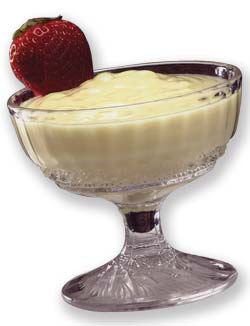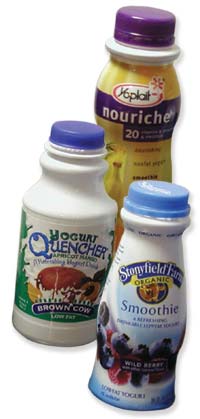
With that said, it is expected that per capita consumption of yogurt in 2002 will come in about 2.5% higher than 2001, or around 7.1 lbs, according to projections by the International Dairy Foods Assn. This is growth the industry cannot ignore.
“One of the reasons for this growth is we now have a good solid decade of consumers who grew up eating yogurt,” says Gary Hirshberg, CEO and pres., Stonyfield Farm Inc., Londonderry, N.H. “Today’s young adults were part of the wave in the early 90s of the under-12 group who were regularly fed yogurt as a snack. For this consumer segment, eating yogurt is part of their lifestyle.”
Hirshberg cautions the industry when looking at this growth by saying, “We are growing from a low bar, compared with Europe, where consumption of yogurt is more than three times what it is here. The potential _is enormous.
“We also have to remember that the quality of yogurt in the United States has dramatically improved in the past 20 years,” Hirshberg says. “It is no longer medicinal tasting. Consumers don’t swallow and grimace. They are enjoying yogurt. There are a variety of yogurts in the marketplace, something for everyone’s liking—from European-style to products that resemble pudding.”
With yogurt no longer considered an occasional purchase, rather it’s something regularly stocked in home refrigerators, the trend in dedicating dollars and time to product research is changing. For example, researchers at the University of Wisconsin, Madison, have received funding from the Hatch Act of 1887, which provides federal research dollars that are matched by individual states to land-grant academic institutions. The UW-Madison research team, led by John Lucey, assistant professor, has been trying to reduce syneresis in yogurt by manipulating processing variables rather than through the addition of ingredients, which is the common solution for most U.S. yogurt manufacturers.

“The dilemma is that in order to position a product as a health food, it is desirable to use the least amount of ingredients possible while maintaining appearance and texture properties,” says Lucey. “That’s why it is important for manufacturers to understand how to reduce the amount of stabilizers they use in healthful products like yogurt.
“In many European countries, yogurt contains little or no ‘other ingredients,’ and it is positioned as a healthful, nutritious food, rather than as a treat or snack, like it has been in the United States,” says Lucey. “We are starting to see this attitude change already with brands such as Stonyfield.” Lucey predicts that it is just a matter of time before more U.S. yogurt marketers aggressively position yogurt as a health food.
Lucey’s research focuses on the physico-chemical causes of the surface whey defect, which is formed when yogurt’s gel structure is unstable and shrinks, forcing liquid out. He found that certain manufacturing conditions encourage the formation of an unstable gel. These include the combination of some of the following conditions: High incubation temperature, rapid rate of acidification, excessive heat treatment of milk, low total solids content, low acid production and agitation during gelation.
“Reducing incubation temperatures from 113ÞF to 104ÞF create fewer defects in cup-set yogurt without sacrificing much on production time,” Lucey says. “In the lab, this minimal decrease in incubation temperature produced a very stable skim milk yogurt with just under 11% milk solids and no wheying off at the end of fermentation.”
Lucey’s next steps are to apply his findings from model gel systems to stirred yogurt production. He says that yogurt makers are even less aware of the influence that the original gel has on the final texture of stirred yogurt, as compared to cup-set yogurt, where wheying off would be very apparent. Down the road, it is possible that these findings may transfer to sour cream, sour cream-based dips and cream cheese, where surface whey is also very undesirable.

On the global side
This July, the Codex Standard for Fermented Milks, which includes yogurt, will be finalized. What does this mean to the U.S. cultured dairy products industry, specifically to those in product development?Well, for most dairy businesses, not much, or at least not much for the time being. Codex standards, in general, have little or no impact on most U.S. food processors. This is because Codex standards are simply a reference to individual governments. Each government has the choice to adopt or not to adopt Codex standards. In the United States, any adoption would be reflected in Title 21 of the Code of Federal Regulations. To date, the United States has never changed any of its standards as a result of a final action taken by the Codex Alimentarius Commission, but that can change as the world continues to grow as a global marketplace.
The Codex Alimentarius Commission was created in 1963 by the Food and Agriculture Organization of the United Nations (FAO) and World Health Organization (WHO) to develop international food standards to protect the safety of consumers, ensure fair trade practices and promote coordination of all food standards work undertaken by international governmental and non-governmental organizations.
“The United States has a mechanism in place to review any Codex standard and consider whether or not there should be a corresponding change in the comparable U.S. standard,” says Cary Frye, v.p. of regulatory affairs for IDFA.
Allen Sayler, dir. of regulatory affairs and international standards, IDFA, adds, “When the Codex standard is finalized in July, the U.S. standard will not change; however, there is a chance that in the future the U.S. government may choose to adopt this new Codex standard. Once the Codex standard is finalized, and if different than the CFR, it will immediately impact U.S. dairy exporters shipping to those countries using Codex standards to define their dairy products.”
In January, the International Dairy Federation met for its annual Legislative Week, and the pending Codex Standard for Fermented Milks was on the agenda. Frye and Sayler attended the meeting, acting as advocates for Codex standards that are similar to U.S. dairy standards.
The most significant outstanding issue with this Codex standard is the need to include an extensive list of food additives for fermented milks.
“While a table containing classes of food additives (i.e., stabilizers) is complete, the list of acceptable additives is not,” says Sayler. “IDFA representatives will be involved to insure this list is consistent with U.S. yogurt standards. We really hope the list goes away, and that the standard just defines classes of ingredients, as is the case with the CFR.”
Who knows, things might just turn out that way. After all, a year ago when the draft of the final standard was produced, the United States had a major victory when the standard was written to allow for a maximum of 50% non-dairy ingredients in flavored fermented milks such as flavored yogurt. While U.S. manufacturers typically use around 35% non-dairy ingredients in flavored yogurt, some European countries wanted to limit this to 30%. The finalized level of 50% eliminated the need for U.S. reformulation of exported product or unfair competition in the U.S. marketplace by imported product.
Interestingly, at the January 2003 meeting, the Japan delegation introduced a request to clarify whether the draft Codex standard included fermented milk drinks. There was a general sense that fermented milk drinks were outside of the standard, since such products are made up of more than 50% non-dairy ingredients. If it is eventually determined that these drinks are subject to the standards, there would be concern since such product could not be labeled “Yogurt Drink” or “Fermented Milk Drink.” An action team, which includes an IDFA member, was established in order to review this issue.
Lastly, yogurt manufacturers need to know that the draft Codex standard includes a requirement for a specific level of 107 characterizing microorganisms per gram for yogurt at the end of shelflife. The U.S. standard for yogurt currently does not have the same requirement, but this required standardizing microorganism level is in a revision proposed by the National Yogurt Assn., and currently in the hands of FDA. Verification of culture levels would be measured using samples retained by the manufacturer.
